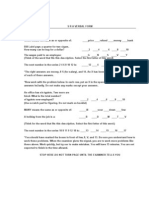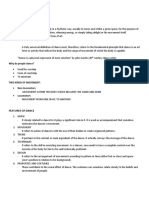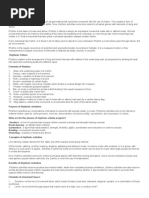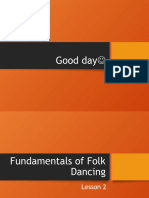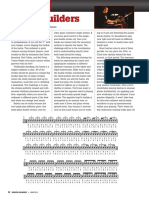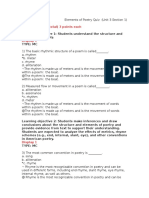Dance Manual Unit 1 F06
Dance Manual Unit 1 F06
Uploaded by
amie29_07Copyright:
Available Formats
Dance Manual Unit 1 F06
Dance Manual Unit 1 F06
Uploaded by
amie29_07Copyright
Available Formats
Share this document
Did you find this document useful?
Is this content inappropriate?
Copyright:
Available Formats
Dance Manual Unit 1 F06
Dance Manual Unit 1 F06
Uploaded by
amie29_07Copyright:
Available Formats
PHYSICAL EDUCATION 110 DANCE MANUAL
UNIT 1 DANCE FOUNDATIONS 1. 2. 3. 4. 5. 6. 7. 8. 9. WHY DO PEOPLE DANCE? MOVEMENT THEMES/ (Movement Education) FUNDAMENTAL LOCOMOTOR MOVEMENT RHYTHM & RHYTHMICAL MOVEMENT ELEMENTS OF DANCE DANCE POSITIONS DANCE FORMATIONS COMMON STEPS DANCE ACROSS THE AGES
SAMPLE ARTICLE
Page 1
1. WHY DO PEOPLE DANCE?
VALUES/GOALS OF A DANCE EXPERIENCE/PROGRAM
COGNITIVE:
AFFECTIVE:
PSYCHO-MOTOR:
Page 2
2.
Page 3
3. FUNDAMENTAL LOCOMOTOR MOVEMENT WALK RUN HOP steps from one foot to the other. similar to walking, emphasis on a faster temp. a transfer of weight by a springing action from one foot to the same foot. one or both feet leave the floor, knees bending: both return to the floor together. a transfer of weight from one foot to the other foot. The movement emphasis is up and over. a step and a shop on the same foot. is a step close step close pattern (slow, quick, slow, quick.)
JUMP
LEAP
SKIP SLIDE
GALLOP moving forward diagonally with a step close step close pattern.
Page 4
4.
RHYTHM & RHYTHMICAL MOVEMENT
Components of Rhythm: 1. Measure: 2. Phrase: 3. Accent: 4. Meter: 5. Tempo: equal group of beats natural group of 2 or more measures variety or intensity number of counts/time signature i.e. 4/4; 2/4 rate of speed
Rhythmical Skills include: Feeling and Expressing Beat (Beat Competency)
Moving with others to a common beat
Movement to a common beat with apparatus
Page 5
5.
ELEMENTS OF DANCE
the combinations, sequences and movements that make up a dance, these can include locomotor and non locomotor movements.
STEPS
PATHWAYS
steps can move through space either in a straight, curved, or zigzag pattern.
DIRECTIONS
dance sequences can use many different directions including forward, backward, diagonal, and sideways to the right or left.
RELATIONSHIPS
dances may be solo, performed with a partner, or with a group, or the actions may also include the use of equipment or apparatus.
FORMATIONS
there are many different formations that dances have, the simple ones are lines, circle, files, scatter, contra, and square.
Page 6
6.
DANCE POSITIONS
References: Harris, Pittman, Waller Dance A While: Burgess Publishing
Page 7
7.
DANCE FORMATIONS
References: Harris, Pittman, Waller Dance A While: Burgess Publishing
Page 8
DANCE FORMATIONS continued
Page 9
8.
Common Steps
1. Two-Step This uneven rhythmic pattern (step-close-step; left, right, left or right, left, right; triple step, or step-ball-change) requires two counts of the music of music (1-and-2) to complete, moving forward, backward, sideward, and diagonally. 2. Grapevine Step to right side on the right foot, step the left foot behind the right root, step the right foot to side, touch the left in front of the right, repeat in multiples of four on both sides. 3. Heel-toe Begin with feet together. Touch the right heel to the right diagonal with a slight hop, bring the right foot in front of the left foot, touch the toe, and hop. Repeat this twice, then slide right three times. Repeat this to the left side. (also called heel-toe polka, heel-toe with three slides) 4. Schottische An even rhythmic pattern (walk, walk, walk, hop), moving forward, backward, sideward, and diagonally. In some cases also followed by four step hops. 5. Polka An uneven rhythmic pattern (gallop and skip or slide and skip), moving forward, backward, sideward, and diagonally. 6. Cha Cha Slow, slow, quick, quick, slow; counted 1, 2, 3-and-4. Basic is forward and backward, cha, cha, cha in place, and then backward and forward, cha, cha, cha in place. 7. Waltz Three smooth walking steps on each beat of the music, counted 1, 2, 3. 8. Charleston Walk forward on the left foot, kick or touch the right foot forward; walk backward on the right foot and touch the left foot back. 9. Lindy Step, step, rock; backward step, using an even rhythm. 10. Bleking Begin with feet together. Hop on the right foot and extend the left foot diagonally, with the heel touching the floor on count one; hop on the left foot diagonally, with the heel touching the floor on count two. Repeat and hold, alternating feet.
Page 10
9. Dance Across the Ages
Primitive Times: Dance ceremonial or religious Dramatic or historic representation of mans chief passions Mimicry or imitation of the movement of animals Ancient Times:( Before and just after Christ) Dance as an Art Values of dance most realized in Athenian civilization Highly structured and demanded great skill Medieval Times: (Middle Ages- 11-12th century)) Concern for life after death Dance is frowned upon Only visible dance is negative (St. Vitus Dance- Dance to Delirium) Late Medieval /Early Renaissance: (15th century) First steps are developed and recorded Court dances begin to develop, with a restrained style Renaissance:(1500-1600s; Baroque-1700s, Romantic /Victorian- 1800s) Renewed interest in culture Dance is accompanied by music Court dances continue to develop Golden age and the birth of Ballet Dance classes and dance master evolve Modern Times: Variety of historical and cultural influences Expressed in the sprit of the individual Earliest dances were waltzes In the 1900s gallop or polka hit Europe and was considered indecent After WW1 dances include shimmy, Charleston, rumba, marathon dances of the 20s ands 30s swing, bunny hop and jive WW2 emerging rock and roll, swing, jitterbug 60s-Twist. 70s- Disco. bump, hustle and a renewed sociological interest 80s-Punk 90s- Rap 2000 and beyond Source: Sachs, C. (1937). World History of Dance. W.W. Norton & Company Inc.
Page 11
You might also like
- SRA TestDocument7 pagesSRA Testapi-1962589786% (76)
- Pathfit3 ReviewerDocument7 pagesPathfit3 ReviewerAydan CabalhinNo ratings yet
- RhythmicDocument34 pagesRhythmicLouise ArellanoNo ratings yet
- Vingt Regards Sur l'Enfant-Jesus: Bartok, (Cranbury, NJ: Associated University Presses, 1996), 17Document11 pagesVingt Regards Sur l'Enfant-Jesus: Bartok, (Cranbury, NJ: Associated University Presses, 1996), 17barrenjerNo ratings yet
- New Rubrics 3 12 PDFDocument15 pagesNew Rubrics 3 12 PDFKatherine MenesesNo ratings yet
- Social DanceDocument8 pagesSocial DanceAlecza Jewen GonzalesNo ratings yet
- Elements of DanceDocument7 pagesElements of DanceGlaiza Adelley BitengNo ratings yet
- Modern DanceDocument40 pagesModern Dancejean ApostolNo ratings yet
- Hope ReviewerDocument4 pagesHope ReviewerMariquel FurioNo ratings yet
- Dance Performing ArtsDocument26 pagesDance Performing ArtsWilson Pagaduan Langcay JuniorNo ratings yet
- RhythmicDocument4 pagesRhythmicJules Adrian Dela PeñaNo ratings yet
- Lesson 10 Ballroom Dances: Florence Jay S. Vasquez PE InstructorDocument24 pagesLesson 10 Ballroom Dances: Florence Jay S. Vasquez PE InstructorRocel Casilao DomingoNo ratings yet
- Social Dance FinalsDocument6 pagesSocial Dance FinalsKhelly Joshua UyNo ratings yet
- Elements of DancesDocument10 pagesElements of DancesAKIRA HarashiNo ratings yet
- TextDocument4 pagesTextJulia MakinanoNo ratings yet
- Modern DanceDocument40 pagesModern DanceKariessa PalamineNo ratings yet
- Lets DanceDocument35 pagesLets DanceYuan ShengNo ratings yet
- Pathfit 3 Module Chapter 4Document10 pagesPathfit 3 Module Chapter 4She KainaNo ratings yet
- DanceDocument4 pagesDanceRoiland Atienza BaybayonNo ratings yet
- Physical Education Finals ReviewerDocument5 pagesPhysical Education Finals ReviewerAnnNo ratings yet
- Pe Chapter 4 ReviewerDocument6 pagesPe Chapter 4 Reviewernd55550% (2)
- Belly Dance Movement VocabularyDocument10 pagesBelly Dance Movement Vocabularycyberchris100% (2)
- Contra DancingDocument6 pagesContra DancingStella AssignmentNo ratings yet
- Dance SportDocument79 pagesDance SportIrish CapioNo ratings yet
- Canvas SHS Pe 3 Week 1Document6 pagesCanvas SHS Pe 3 Week 1Gizelle ANo ratings yet
- Pointers To Review Lesson 1 4Document9 pagesPointers To Review Lesson 1 4NATSU SANFORDNo ratings yet
- Jazz WalksDocument11 pagesJazz Walkspktomlinson6No ratings yet
- PE RevDocument4 pagesPE RevMarianneNo ratings yet
- What Is Cheer Dance?Document40 pagesWhat Is Cheer Dance?lûisNo ratings yet
- New Axial JazzDocument16 pagesNew Axial JazzRea Mariz JordanNo ratings yet
- Modern DancesDocument5 pagesModern Dancesvillanuevajastinenicole2301956No ratings yet
- Pathfit 3 ReviewerDocument7 pagesPathfit 3 Reviewerlianneespanto8No ratings yet
- Introduction of The Line Dance, History, and Common Line Terms Week 1 To Week 4Document20 pagesIntroduction of The Line Dance, History, and Common Line Terms Week 1 To Week 4Stella AssignmentNo ratings yet
- Ballroom DancingDocument5 pagesBallroom DancingChelsea BorgoniaNo ratings yet
- Elements of DanceDocument22 pagesElements of DanceJensine AsiaNo ratings yet
- Social & Ballroom DancesDocument37 pagesSocial & Ballroom DancesKyla Renz de Leon0% (1)
- Lesson 3: Types and Elements of Dance: Module No. 1: Introduction To DanceDocument28 pagesLesson 3: Types and Elements of Dance: Module No. 1: Introduction To Dancegothic wontonNo ratings yet
- Powerpoint - Hope 3 PDFDocument50 pagesPowerpoint - Hope 3 PDFBenedict P. Dizon100% (2)
- Handout 1st QDocument2 pagesHandout 1st QjsvoirsycheNo ratings yet
- Lesson-3.Elements of DanceDocument23 pagesLesson-3.Elements of DanceIsabella SamsonNo ratings yet
- Dance12Document26 pagesDance12chanalya51No ratings yet
- Pathfit 3 Midterm NotesDocument7 pagesPathfit 3 Midterm NotesMia MagbanuaNo ratings yet
- Hope - 3 ReviewerDocument3 pagesHope - 3 ReviewerPauline TayanesNo ratings yet
- Dance 2Document20 pagesDance 2Richmond RojasNo ratings yet
- Dance Terms Common To Philippine Folk DancesDocument7 pagesDance Terms Common To Philippine Folk DancesSaeym SegoviaNo ratings yet
- Ballroom DanceDocument2 pagesBallroom DanceMa. Lea MacheteNo ratings yet
- Unit 2 - Modern CreativeDocument8 pagesUnit 2 - Modern CreativeJorenal BenzonNo ratings yet
- Line DancesDocument16 pagesLine DancesAmediazNo ratings yet
- Week 1 5 Pe 2Document6 pagesWeek 1 5 Pe 2John bryan DuranNo ratings yet
- Pathfit 3 Dance Prelim HandoutsDocument7 pagesPathfit 3 Dance Prelim Handoutsgraciamark009No ratings yet
- P E1Document6 pagesP E1Rojan MagalongNo ratings yet
- PE 2 Folk Dance and Rhythmic ActivitiesDocument12 pagesPE 2 Folk Dance and Rhythmic Activitiestarinaytiffany82No ratings yet
- PE Second Pre-Quarterly NotesDocument3 pagesPE Second Pre-Quarterly NoteshjNo ratings yet
- DANCEDocument1 pageDANCEjoannafechuaaNo ratings yet
- COR 019 Reviewer 1st Achivement TestDocument3 pagesCOR 019 Reviewer 1st Achivement TestZane BevsNo ratings yet
- PE 7 Lesson 2 Fundamentals of Folk Dancing Lesson 3 Local and Indigenous DancesDocument19 pagesPE 7 Lesson 2 Fundamentals of Folk Dancing Lesson 3 Local and Indigenous DancesGab JulianNo ratings yet
- PRACTICE-AND-MOVEMENT (Dance)Document56 pagesPRACTICE-AND-MOVEMENT (Dance)sabel sardillaNo ratings yet
- Sarah Evaristo BSNDocument4 pagesSarah Evaristo BSNKrizzia Mae EscasinasNo ratings yet
- ISO 9001 FDIS Transition Guide FINAL July 20150001Document38 pagesISO 9001 FDIS Transition Guide FINAL July 20150001amie29_07100% (1)
- Iso 9000 Certification and Business Performance ofDocument23 pagesIso 9000 Certification and Business Performance ofamie29_07No ratings yet
- Institutionalization of ISO 9001 QMSDocument27 pagesInstitutionalization of ISO 9001 QMSamie29_07No ratings yet
- 21 Irrefutable LawsB - Maxwell.ebsDocument12 pages21 Irrefutable LawsB - Maxwell.ebsamie29_07No ratings yet
- Regional Trial Court: Master List of Incumbent JudgesDocument39 pagesRegional Trial Court: Master List of Incumbent Judgesamie29_07100% (1)
- Early Journal Content On JSTOR, Free To Anyone in The WorldDocument27 pagesEarly Journal Content On JSTOR, Free To Anyone in The Worldamie29_07No ratings yet
- RTCDocument39 pagesRTCMigz DimayacyacNo ratings yet
- Be It Enacted by The Senate and House of Representatives of The Philippines in Congress AssembledDocument17 pagesBe It Enacted by The Senate and House of Representatives of The Philippines in Congress Assembledamie29_07No ratings yet
- Traditional Ghanaian Dance and Its Role in Transcending Western Notions of CommunityDocument24 pagesTraditional Ghanaian Dance and Its Role in Transcending Western Notions of CommunitytieyusifNo ratings yet
- The 7th Chord.: Lesson 4. Ears, Habits & Rhythmic Time Feel. 4.1 HarmonyDocument7 pagesThe 7th Chord.: Lesson 4. Ears, Habits & Rhythmic Time Feel. 4.1 HarmonyDANANo ratings yet
- Elem Music Curriculum K-5Document20 pagesElem Music Curriculum K-5Princess De PuntualNo ratings yet
- Amanda HallDocument108 pagesAmanda HallCadenia Learning CentreNo ratings yet
- Math Patterns Lesson KindergartenDocument4 pagesMath Patterns Lesson Kindergartenapi-336646580No ratings yet
- 1240Document13 pages1240ocicyahNo ratings yet
- Mixed CatalogueDocument20 pagesMixed CatalogueCMCIrelandNo ratings yet
- Larson Blake - Minoi Minoi Mind MapDocument1 pageLarson Blake - Minoi Minoi Mind Mapapi-441634391No ratings yet
- Activity 1 Directions: Answer The Following Questions. Minimum of 5 Sentences. Submit It in A PDFDocument1 pageActivity 1 Directions: Answer The Following Questions. Minimum of 5 Sentences. Submit It in A PDFREILENE ALAGASINo ratings yet
- Department of Education: Region Xi Schools Division of Davao OrientalDocument9 pagesDepartment of Education: Region Xi Schools Division of Davao OrientalLEONARD JIM DUMADANGONNo ratings yet
- English Yearly Scheme of Work Year 1 SJKDocument16 pagesEnglish Yearly Scheme of Work Year 1 SJKHuai Mee KhewNo ratings yet
- M, Materialism and PL. EIC 2010Document22 pagesM, Materialism and PL. EIC 2010Laura Leander WildeNo ratings yet
- Sampaguita Womens SHG AmontayDocument13 pagesSampaguita Womens SHG AmontayJeric LeonesNo ratings yet
- Department of Education: Detailed Lesson Plan in MAPEH 6Document11 pagesDepartment of Education: Detailed Lesson Plan in MAPEH 6jamz juneNo ratings yet
- The Cambridge History of Western Music Theory PDFDocument18 pagesThe Cambridge History of Western Music Theory PDFsupermayito29% (7)
- Ge6115 Art Appreciation Quizzes Prelim Midterm Finalsshgaring Is Caring That Is WhyDocument14 pagesGe6115 Art Appreciation Quizzes Prelim Midterm Finalsshgaring Is Caring That Is WhyDammy F0% (1)
- Q2 Wk4 Woorsheet4 MUSIC10Document7 pagesQ2 Wk4 Woorsheet4 MUSIC10bonzai guillenaNo ratings yet
- Interior Desing: Basic English 1 - Fau 2020Document8 pagesInterior Desing: Basic English 1 - Fau 2020MARIA LILIANA MARTINEZ GUTIERREZNo ratings yet
- Arab Iqa'atDocument5 pagesArab Iqa'atrenewedNo ratings yet
- MD-2010.06 - Bill Bachman - Chop Builders 4 - HairtaDocument2 pagesMD-2010.06 - Bill Bachman - Chop Builders 4 - HairtaNICKONINONo ratings yet
- Presentation 2 - PRINCIPLES OF COMPOSITIONDocument40 pagesPresentation 2 - PRINCIPLES OF COMPOSITIONGina Ann MaderaNo ratings yet
- The Art of The Player-Piano - A Text-Book For Student and Teacher (By Sydney Grew) (1922) PDFDocument350 pagesThe Art of The Player-Piano - A Text-Book For Student and Teacher (By Sydney Grew) (1922) PDFMatthieuNo ratings yet
- Visual RhythmDocument29 pagesVisual RhythmDaniel Goff100% (1)
- Part 7 Grade 9 Edumate Playing Chords On The Piano KeyboardDocument40 pagesPart 7 Grade 9 Edumate Playing Chords On The Piano KeyboardAndrewOribianaNo ratings yet
- Spa Music Grade9 q1 Slmodule3Document18 pagesSpa Music Grade9 q1 Slmodule3jonquintanoNo ratings yet
- Cool Memories: Notes On The Ligeti Viola Sonata John Stulz (2012)Document29 pagesCool Memories: Notes On The Ligeti Viola Sonata John Stulz (2012)Florian Wessel100% (1)
- English Elements of Poetry QuizDocument10 pagesEnglish Elements of Poetry QuizAnonymous vWGIbfP100% (1)
- Grade Level: Grade 7 Subject: Mapeh Time Allotment: 60 Minutes in A WeekDocument13 pagesGrade Level: Grade 7 Subject: Mapeh Time Allotment: 60 Minutes in A WeekCher Jess Castro ValesNo ratings yet
